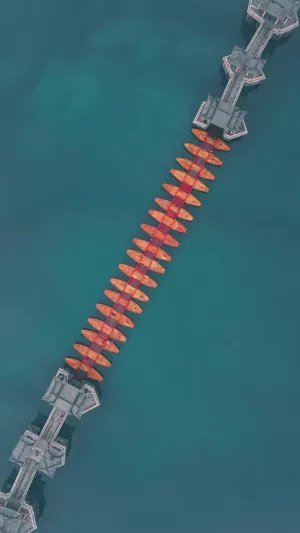Bridges, while common in our daily lives, come in various forms, serving not only as connections but also as sources of aesthetic delight. Some bridges stand out for their unique designs and functionalities, offering a sensory and psychological experience.
In this exploration, we will introduce four of the most extraordinary bridges worldwide that go beyond conventional structures.
Guangji Bridge, China:
The Guangji Bridge in China is a remarkable combination of floating beams, featuring two stone girder bridges on the east and west and a floating bridge in the middle. This innovative structure comprises three main elements: piers, stone beams, and bridge pavilions. Spanning a total length of 518 meters, the east girder bridge extends 283.35 meters with 12 piers and 12 bridge holes. Meanwhile, the west beam bridge, 137.3 meters in length, boasts 8 piers, 7 bridge holes, and a 5-meter-wide stone beam.
The unique aspect of the Guangji Bridge lies in the nearly 100-meter stretch of broken bridges between the two structures, cleverly reconnected by 18 wooden boats. This inventive design allows ships to pass through when assembled in a line and restores a continuous waterway when disassembled.
Moses Bridge, Netherlands:
The Moses Bridge in the Netherlands defies conventional bridge designs by not spanning across the river but sinking into the water, creating a pathway beneath the water's surface. From a distance, the bridge remains nearly invisible, offering a surreal experience for pedestrians who feel as though they are walking through the river.
The bridge seamlessly integrates with the surrounding landscape and connects to a magnificent fort on one side, creating a picturesque scene. To ensure durability and resilience against decay, the bridge's structure is crafted from fully waterproof wood, resembling a submerged trench. Additionally, concerns about potential river overflow are alleviated by the presence of dams on both sides controlling the water height.
Trampoline Bridge, Paris:
Floating on the Seine River in Paris, France, the Trampoline Bridge is an unconventional structure consisting of three inflatable components, each with a 30-meter diameter and filled with 3700 cubic meters of air. The middle section of these inflatables functions as a trampoline, giving the bridge its whimsical name.
The designer aimed to offer people a novel and entertaining way to cross the ancient and beautiful river, turning the journey into an engaging experience. This imaginative and playful design exemplifies how bridges can be more than just practical structures, becoming interactive elements that enhance the urban environment.
Laguna Garzon Bridge, Uruguay:
The Laguna Garzon Bridge in Uruguay challenges traditional straight-line or arch bridge designs by adopting a circular shape. This distinctive choice was driven by the architect's concern for the stunning nearby scenery distracting drivers and potentially causing accidents. To mitigate this risk, the original straight-line distance was transformed into two curved detours.
The intentional detours compel drivers to slow down and maintain focus, minimizing the likelihood of accidents. This thoughtful design not only ensures safety but also allows travelers to appreciate the scenic beauty without compromising their well-being.
In unveiling these extraordinary bridges, it becomes evident that these structures transcend mere functionality, evolving into artistic expressions that engage and enchant all who encounter them. Each bridge tells a unique story, showcasing the marriage of form and function in the world of civil engineering.





